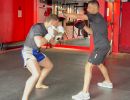Kickboxing is one of the most powerful and exciting sports in the world. It combines punches, kicks, and footwork to build strength, speed, and stamina. Whether you want to lose weight, learn self-defense, or become stronger, kickboxing can be a great choice for you.
This beginner’s guide to kickboxing will explain everything you need to know about the sport. You’ll learn its benefits, how to get started, what gear you need, basic techniques, and common mistakes to avoid. Let’s dive into the world of kickboxing for beginners!
What is Kickboxing?
Kickboxing is a martial art and combat sport that combines punching and kicking techniques. It takes moves from karate, boxing, Muay Thai, and other martial arts. It can be used for fitness, self-defense, or competition.
There are different styles of kickboxing, including:
- American Kickboxing – Focuses on punches and high kicks.
- Muay Thai (Thai Kickboxing) – Includes elbows, knees, and clinching.
- Japanese Kickboxing – Similar to Muay Thai but with its own rules.
- Cardio Kickboxing – A fitness workout that uses kickboxing moves with music.
Benefits of Kickboxing for Beginners
Kickboxing offers many physical, mental, and emotional benefits, especially for those just starting. If you’re new to the sport, you’ll quickly see why kickboxing for beginners has become so popular.
1. Full-body Workout
Kickboxing works your arms, legs, core, and back. Every punch, kick, and squat helps tone your body and burn fat.
2. Weight Loss
You can burn up to 700–900 calories in just one kickboxing session. It’s perfect for those who want to lose weight fast.
3. Self-Defense
Kickboxing teaches you real techniques to defend yourself in dangerous situations.
4. Stress Relief
Hitting the bag can release stress and anger. It helps you feel calm and focused.
5. Improves Confidence
As you get stronger and learn new moves, you will feel more confident about yourself.
6. Builds Discipline
Regular training teaches you commitment, focus, and patience.
What You Need to Start Kickboxing
As a beginner, you don’t need to buy everything at once. But some basic gear will help you train safely.
Essential Kickboxing Gear:
- Boxing Gloves – To protect your hands and wrists while punching.
- Hand Wraps – Provide extra support to your knuckles and wrists.
- Mouth Guard – Important for sparring to protect your teeth.
- Shin Guards – Protect your shins while practicing kicks.
- Kickboxing Shorts or Leggings – Comfortable clothes that allow movement.
- Training Shoes or Barefoot – Depends on your gym rules.
Kickboxing for Fitness vs. Kickboxing for Fighting
Before you begin, ask yourself:
Do I want to learn kickboxing for fitness or for fighting?
Kickboxing for Fitness:
- Focus on burning calories and toning muscles.
- No contact or sparring.
- Great for beginners who just want to stay healthy.
Kickboxing for Fighting:
- Focus on techniques, power, and timing.
- Includes sparring, pad work, and partner drills.
- Suitable for those interested in martial arts or self-defense.
How to Start Kickboxing – Step by Step
If you’re serious about getting started, this step-by-step guide to kickboxing for beginners will help you feel confident and prepared.
Step 1: Choose a Kickboxing Gym
Find a gym near you that offers beginner kickboxing classes. Make sure the coaches are qualified and friendly.
Step 2: Join a Beginner Class
Many gyms offer beginner programs that teach the basics at a slow and easy pace.
Step 3: Learn the Basic Techniques
Start by learning the basic punches and kicks. Don’t rush. Focus on good form.
Step 4: Train Regularly
Attend classes at least 2–3 times per week. Stay consistent to improve.
Step 5: Track Your Progress
Measure your fitness, technique, and confidence. Celebrate your progress.
Basic Kickboxing Techniques for Beginners
Here are the most important moves every beginner should learn:
Punches:
- Jab – A quick, straight punch with your front hand.
- Cross – A powerful straight punch with your back hand.
- Hook – A punch that comes from the side.
- Uppercut – A punch that goes upward under the opponent’s chin.
Kicks:
- Front Kick – A straight kick using the ball of your foot.
- Roundhouse Kick – A powerful kick with your shin.
- Side Kick – A kick that comes from the side with the heel.
- Push Kick (Teep) – Used to create distance.
Footwork:
- Stay on your toes.
- Step forward, backward, and side to side.
- Always return to your fighting stance.
Common Mistakes to Avoid in Kickboxing
As a beginner, it’s easy to make small mistakes. Here are the most common ones:
1. Forgetting to Breathe
Holding your breath makes you tired fast. Always breathe during moves.
2. Dropping Your Hands
Keep your hands up to protect your face.
3. Using Too Much Power
Focus on technique first. Power will come later.
4. Not Warming Up or Stretching
Always warm up your body and stretch to avoid injuries.
5. Skipping Rest Days
Your body needs time to recover. Don’t train every day.
Kickboxing Workout for Beginners (Sample Routine)
This kickboxing for beginners workout is simple, effective, and can be done anywhere.
Warm-Up (5 minutes):
- Jumping jacks
- Arm circles
- Leg swings
- Light shadowboxing
Main Workout (20 minutes):
- Jab-Cross combo – 2 minutes
- Front kicks – 2 minutes
- Jab-Cross-Hook – 2 minutes
- Roundhouse kicks – 2 minutes
- Shadowboxing freestyle – 4 minutes
- Core workout (planks, crunches) – 5 minutes
- Cool down stretches – 5 minutes
Kickboxing Diet Tips for Beginners
Fueling your body the right way is important for energy and recovery.
Before Training:
- Eat a light snack (banana, oats, smoothie) 1 hour before class.
After Training:
- Drink water.
- Eat protein and healthy carbs (chicken, eggs, rice, fruits).
Daily Habits:
- Drink at least 2 liters of water.
- Avoid junk food and soda.
- Get 7–8 hours of sleep.
FAQs – Kickboxing for Beginners
1. Is kickboxing hard for beginners?
No. Kickboxing for beginners is designed to be easy and fun if you start slow and follow your coach’s advice.
2. Do I need to be fit to start kickboxing?
No. Kickboxing helps you get fit. Anyone can start, no matter your fitness level.
3. Is kickboxing good for weight loss?
Yes. It’s one of the best sports for burning fat and losing weight fast.
4. Can I do kickboxing at home?
Yes. You can start with shadowboxing and basic drills. But joining a gym is better for learning proper techniques.
5. How often should I train?
Beginners should start with 2–3 sessions per week.
6. Will I get injured in kickboxing?
If you wear the right gear and follow safety rules, injuries are rare.
7. How long does it take to see results?
You may start feeling stronger and fitter within 3–4 weeks of regular training.
Conclusion – Why You Should Try Kickboxing Today
Kickboxing is more than just a sport. It’s a full-body workout, a stress reliever, a confidence booster, and a way to learn self-defense. For beginners, it’s one of the best ways to get in shape, make friends, and stay motivated.
So if you’ve been thinking about starting something new and exciting, kickboxing for beginners is the perfect place to begin. Step into your first class, and you might just fall in love with it.
Ready to unleash your power? Join Final Round Kickboxing Fitness Gym Dubai – where beginners become champions!





